Russel Arnold: Sri Lanka’s Forgotten ODI Star By Michael Roberts
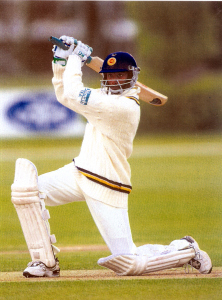
Source:cricketique.live
During the course of the World Cup 2015 watchers were occasionally served up statistical tables of leading run-scores in the history of World Cup or ODI cricket. Sri Lankan fans would have been especially attentive to those featuring Sangakkara’s stellar career and record breaking levels. On one such occasion I was intrigued to see Russel Arnold’s statistics appear at the tail-end of an august list of names.
Primed by Arnold’s appearance as a TV commentator and his impeccable performance in this role, I proceeded to do some research on the topic and began with a statistical picture of a comparative kind that is quite revelatory. This picture raises issues about media-hype and our very own memory banks.
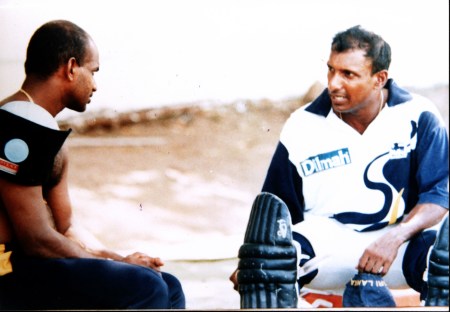
Sanath and Aravinda in earnest conversation at practice
It would be fair to say that the batsmen stars in the ODI memory store of Sri Lankan cricket enthusiasts over the last twenty years are Aravinda De Silva, Sanath Jayasuriya and Arjuna Ranatunga from the older cohort and Sangakkara, Mahela Jayawardene and TM Dilshan from the present over-30’s layer. So it is that the Wikipedia entry on the “Sri Lankan national team” runs thus:
Sri Lanka’s national cricket team achieved considerable success beginning in the 1990s, rising from underdog status to winning the Cricket World Cup in 1996. Since then, the team has continued to be a force in international cricket. The Sri Lankan cricket team reached the finals of the 2007 and 2011 Cricket World Cups consecutively. But they ended up being runners up in both those occasions.[2] The batting of Sanath Jayasuriya, Aravinda de Silva, Mahela Jayawardene, Kumar Sangakkara and Tillakaratne Dilshan backed up by the bowling of Muttiah Muralitharan, Chaminda Vaas, Lasith Malinga and Ajantha Mendis, among many other talented cricketers, has underpinned the successes of Sri Lankan cricket in the last two decades.
Cricketing oldies who watched ODI matches in the 1990s and the early 2000s may also dwell occasionally on batsmen Asanka Gurusinha, Roshan Mahanama, Romesh Kaluwitharana and Hashan Tilakaratne because (1) of their role in some coruscating matches in the 1990s and (2) particularly their participation in the team performances that secured the World Cup in 1996.
Thus, I conjecture that Russel Arnold (as well as Marvan Atapattu) would rarely figure in their retrospective thoughts on the giants among the batting group. So, he is a forgotten star in Lanka’s ODI firmament. Statistical comparisons serve as the first step in my journey of recovery. They are revelatory.
As a hors d’oeuvre, let me indicate that in the ODI averages for Sri Lanka Arnold’s 35.26 is more or less on par with Arjuna Ranatunga and fifth behind Sangakkara (41.96), Dilshan, Atapattu and Arjuna. It therefore falls into the 30-40 range like Dilshan, Atapattu, Arjuna, Aravinda, Sanath and Mahela. Thus his ODI average is better than, say, Sanath Jayasuriya’s. In ODI strike-rate for Sri Lanka at 72.5 he is eighth in my selective pool and falls within the 70-80 range — a level below the heights reached by Jayasuriya (91.27), Dilshan (86.14) and Aravinda (81.13), but well above Asanka Gurusinha (60.92) and Hashan Tillakaratne (57.56).
Such comparisons must be subject to caveats that recognise the different scales of run-making in the last four-five years (2010-15) because of significant changes in the rules governing balls and field placements as well as the technological improvements in bats. I provide the full statistical picture as a table before venturing upon clarifications and qualifications.
| Inns. | N/O | Runs | HS | Ave | SR | |
| A Ranatunga | 255 | 47 | 7,456 | 131* | 35.84 | 77.90 |
| A de Silva | 296 | 30 | 9,284 | 145 | 34.90 | 81.13 |
| A Gurusinha | 143 | 05 | 3,902 | 117* | 28.27 | 60.92 |
| H Tillakaratne | 168 | 40 | 3,789 | 104 | 29.20 | 57.56 |
| S Jayasuriya | 429 | 18 | 13,364 | 189 | 32.51 | 91.27 |
| R Kaluwitharana | 181 | 14 | 3,711 | 102* | 22.22 | 77.70 |
| M Atapattu | 259 | 32 | 8,529 | 132* | 37.57 | 67.72 |
| R Arnold | 155 | 43 | 3,950 | 103 | 35.26 | 72.50 |
| T Dilshan | 288 | 41 | 9,796 | 161* | 39.65 | 86.14 |
| M Jayawardene | 413 | 38 | 12,381 | 144 | 33.01 | 78.67 |
| K Sangakkara | 373 | 40 | 13,975 | 169 | 41.96 | 78.88 |
| A Gunawardene | 67 | 01 | 1,708 | 132 | 28.46 | 71.49 |
| C Silva | 62 | 07 | 1,587 | 107* | 28.85 | 70.37 |
Table sorted by year of birth
The table provides a generalised numerical picture. Before refining the analysis, we will profit from a comparison with the statistics for two of Australia’s best middle-order batsmen covering the 1990s and 2000s respectively, namely, Michael Bevan and Michael Hussey — both easily outdoing the Sri Lankan lot in their averages … with Bevan listed first in the box below.
| Inns. | N/O | Runs | HS | Ave | SR |
| 196 | 67 | 6,912 | 108* | 53.58 | 74.15 |
| 157 | 44 | 5,442 | 109* | 48.15 | 87.16 |
Since averages serve as one line of comparative evaluation, it is critical for us to take note of the weight of not out innings in the process. This feature in its turn is more pronounced among middle-order batsmen who, not infrequently, come in towards the end of an innings and perhaps even help secure a victory. Russel Arnold’s proportion of not outs in ODIs matches (roughly) that of Michael Hussey and is by far the largest proportion among the Sri Lankans. Though Arjuna Ranatunga has more, namely, 47 not outs, he had 255 ODI innings to 155 for Arnold.
Refining our comparative analysis, therefore, requires attentiveness to the specialist role and difficulties of those who enter the field quite late in the innings on a substantial number of occasions. At such moments they do not have the time to build an innings. They serve as “finishers” and their risk element is greater. However, on other occasions they may walk in after an early order collapse and have to shore up the innings in ways that may bear on their strike-rate.
Arnold: Chequered Career
Not many will be aware that Russel Arnold was an opening batsman at St. Peters College, Colombo and made his mark in Under 19 international cricket — on a tour of England in 1992 — in this role. He scored 242 runs at an average of 48.40 in three Tests in England at this level. However the prospects of entry into the Sri Lankan side were restricted because of the presence of experienced and competent batsmen in the existing line-up: Mahanama, Jayasuriya, Gurusinha, Aravinda de Silva, Arjuna Ranatunga, Tillakaratne and, more controversially, Sanjeewa Ranatunga.
Though Gurusinha left the island for Melbourne circa 1996/97 Arnold did not get an opportunity to show his wares as opener till the Pakistan tour of Sri Lanka in 1997. However, he was in competition with the technically correct Marvan Atapattu (older by three years). Grapevine gossip suggests that he also had to face the prejudices of some Ananda-Nalanda figures in team and/or Board circles.[1]
It was not till the Sri Lanka team’s debacle during the World Cup in England in 1999, when a squad that was picked[2] by Arjuna Ranatunga failed miserably, that the doors opened. The English disaster enabled the Chandrika Kumaratunga government to sideline the BCCSL board commanded by Thilanga Sumathipala and insert an Interim Committee headed by Rienzi Wijeytilleke.
This opened the door for Arnold, but at this stage he had to compete with Marvan Atapattu and Avishka Gunawardene as well as the mercurial Kaluwitharana for the opening slot alongside the new captain Sanath Jayasuriya. Given Atapattu’s technical competence and right-hand stance, it is not surprising that the Selectors usually fixed on a left-right opening combination of violence (Jayasuriya) combined with right-handed steadiness (Atapattu).[3]
While Arnold was slotted in at No. 3 on a few occasions at either Test or ODI games, the possibility of fitting in as No. 3 was soon closed by the emergence and success of Mahela Jayawardene and Kumar Sangakkara.[4] Jayawardene’s elegance and classiness in batting style and Sangakkara’s correctness tended to overshadow Arnold’s more laboured methods — however effective they were.
Then, guided perhaps by Dav Whatmore, the various Selection Committees of the early 2000s chose to shift Arnold into the middle order at 5, 6 or 7 where his coolness under pressure was deemed handy. As Skandakumar (a perceptive observer of the cricket scene) indicated to me, “Tony Greig was one of the first to acknowledge {Arnold’s] grit and leadership qualities….. he was cool and confident until they started messing around with his place in the batting order” (email, 7 April 2015). Likewise, a local writer assessed his capacities thus: “He was the ideal man for a crisis. On many an occasion, when Sri Lanka’s top order batsmen failed, the rangy left hand bat came to the rescue of the team” (Palipane 2011).
Arnold’s middle-order position in ODI matches was sustained in the mid-2000s when Tom Moody was coach. As the latter indicated: “Russel was considered a good finisher, we tried to mould him into a Bevan like finisher for SL, he had all the characteristics & skills of a player that was calm under pressure plus had the ability to find the boundary when required. ODI cricket back then the role of your middle order was one of the keys to your success hence the importance of players like Russel in your top 7.”[5]
Arnold’s cricketing nous on this issue came through in our Skype chats: he indicated that at No. 6 or 7 he considered his initial task was to nudge the singles so that the set higher order batsman would gain the strike; and where he had got his eye in and was joined by lower-order batsmen his task was to accumulate runs while nursing and/or encouraging them. He added that he could hit fours when required. By way of illustration, in the first ODI against England on a difficult pitch at Rangiri (Dambulla) Sri Lanka in early 2001 Arnold walked in at 58 for 4 wkts with Atapattu at the crease and accumulated 39 runs (not out) in 83 balls to join Atapattu and shepherd the team to 144 for 5 in 40 overs, thereby surmounting England’s low total of 143.[6] In summary, one could say that Arnold was a team man to the core.
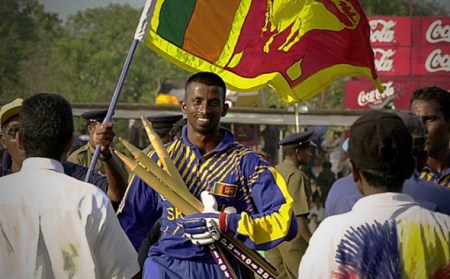
Russel walks back in triumph with trophies –Pic from AFP via islandcricket
It is in this middle-order role that Arnold played an important part in Sri Lanka’s ODI contests in the 2000s, especially in Australia in early 2006 and then in lesser note during the World Cup in the Caribbean in 2007.[7] Sri Lanka outplayed South Africa to reach the ODI finals in Australia, but was comprehensively beaten by the home team under Ponting at Sydney and Brisbane after defeating them at Adelaide.[8] Arnold batted at No. 5 (not 6 or 7) in all three matches in the final set and scored 24, 64 n/o. and 76 runs. In fact, he ended the Australian tour with a total of 312 runs in ten innings for an average of 53.50.[9]
He complemented this batting role with useful part-time bowling interventions as an off spinner on the one hand and competent fielding on the other. It was Arnold who ran out Darren Lehmann in one ODI match in Brisbane with a direct hit, inducing Lehmann to yell “Black Cunts” as he passed the Lankan dressing room. It was Arnold who dismissed Mathew Hayden and Adam Gilchrist before they took off in murderous flight during Sri Lanka’s first encounter with the eventual champions at St George’s ground on 16th April during the 2007 World Cup.[10]
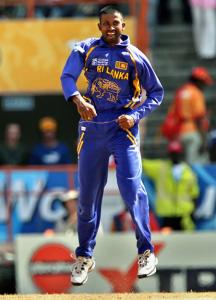
Arnold overjoyed at success in dismissing Gilchrist — Pic from AFP
Despite this prominent role, he does not seem to have been assured of a place in the ODI Elevens or touring squads. Between 2001 and 2007 he had to compete at various points with Indika de Saram, Mubarak, Dilshan, Kapugedera and Chamara Silva for the slots 6 and 7. Arnold himself remains quite miffed about the fact that he was “in and out” of the team in this period.
It is an opinion shared by Nirgunan Tiruchelvam who, writing in early 2006 after Arnold’s useful showing during a tour of Australia, birched the Selection Committee headed by Lalith Kaluperuma for their “shoddy treatment of Russel Arnold, who is the eternal scapegoat of the selectors.”[11] This criticism is preceded by Tiruchelvam’s assessment of Arnold’s services in Australia: “Despite the pressures of batting at the death, Arnold rose to the occasion. He was proactive in his shot-making and nimble between the stumps. His calm demeanour was a constant asset to the team. Where he was found wanting in that he played too many nudges and adventurous sweep shots, especially in the league matches. This was rectified in the finals where the NCC batsman hit the ball in front of the stumps with the full face of the bat” (2006).
Consideration of this charge in relation to his Test career calls for a separate and careful analysis.[12] But the accusation holds good for the shorter version of the game and embraces several lots of Selectors, though not all.
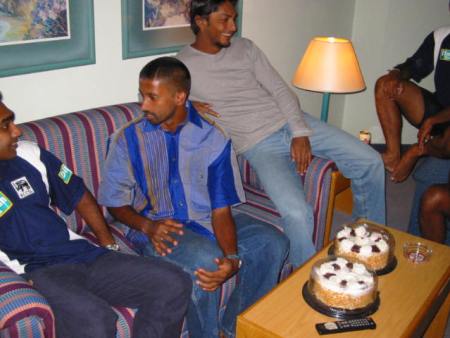 A birthday cake in hotel room in the Caribbean for Arnold together with the lads —Pic by Ajit Jayasekera
A birthday cake in hotel room in the Caribbean for Arnold together with the lads —Pic by Ajit Jayasekera
A Review
So, Arnold’s career in both longer and Test and shorter ODI formats has been chequered. What must be emphasised here is the weight of his contribution to Sri Lanka in the shorter form of the game. To end with an ODI average superior to that of Aravinda and Mahela, and a decent strike-rate of 72.5, is no mean feat. The questions that arise are these: (A) Why did the various clusters of selectors chose him for only 180 ODI matches — enabling 155 innings? (B) Why was he not a certainty? and (C) Why was he in and out of the XI or several touring squads? And (D) why is he not etched in our firmament with the other stars?
My answer to these questions is presented now in point-form. Any evaluation requires a multi-factorial analysis, which in turn demands relative weights. The latter is impossible without a minute analysis proceeding in temporal order. So it is a rough set that I present now — with some factors in conjectural form.
At any moment a Selection Committee is faced with several options for some spots and the balance of the XI or the touring squad has to be evaluated. When Arnold was at the door as an opening batsman from 1996/97 or thereabouts that specific door was closed by the option of Jayasuriya and Atapattu as a right/left combination in both ODIs and Test arenas.[13] It is when Arnold had begun to prove his value in the middle-order from 1999 onwards and such astute observers of the Lankan scene as Greig and Skandakumar recognised this asset that one can raise questions about selection policy in the 2000s.[14] This requires a series by series analysis — a task not attempted here
As a general proposition, however, it can be conjectured that some Selection Committees or key individuals within these bodies
- Were put off by Arnold’s batting style. As Tiruchelvam notes in early 2006: “It could be because he is not as attractive a batsman as some of his counterparts. His odd stance has become squarer and more crouched.”
- Were inadequately appreciative of the special difficulties of batsmen located at Nos 6 and 7 — in effect displaying a fundamental failure in cricketing acumen.
- Were perhaps informed by “pettiness” (Tiruchelvam’s term) and possibly directed by prejudices rooted in the Sinhala Buddhist mind-set arising from the 1956 revolution, with its antipathy to the westernized English-speaking elites of that era.
- Were perhaps informed by the immature considerations of superiors peeved by Arnold’s directness of speech and tendency to call a spade a spade — outspokenness that could ruffle the feathers of men burdened by self-importance.
- And, THEN, last but not least, there was the impact of Sri Lanka’s perennial problem: namely, the constant musical chairs in cricket administration and thus in the composition of Selection Committees. A glance at Wikipedia on this topic will reveal eleven — yes ELEVEN — different heads of SLC between 2000 and 2015. The absence of continuity in oversight is manifest is it not!
In the light of Point Four the marvel is that Sri Lankan cricket teams have been competitive in all three formats of international cricket and secured trophies or reached the finals on several occasions. This is the product, on the one hand, of the enthusiasm and dedication of many coaches and administrators at all levels and, on the other, the boundless commitment and athletic capacities residing in the players who have competed for positions. Russel Arnold has been one such example.
That is not all. Together with Marvan Atapattu he has to be placed among the stars lighting up the night sky of our ODI cricket.
![Arnold [now re-located in Sydney] as TV commentator in New Zealand](https://www.elanka.com.au/wp-content/uploads/2022/01/Arnold-overjoyed-at-success-in-dismissing-Gilchrist-—-Pic-from-AFP.jpg)
Arnold [now re-located in Sydney] as TV commentator in New Zealand
SELECT BIBLIOGRAPHY
Brettig, Daniel 2014 “BLACK CUNTS”!! A Racial Outburst from Lehmann becomes a lesson for all time,” 29 April 2014, https://cricketique.live/2014/04/29/black-cunts-a-racial-outburst-from-lehmann-becomes-a-lesson-for-all-time/
Hopps, David 2003 “Australia’s Lehmann on racism charge,” 17 January 2003, http://www.theguardian.com/sport/2003/jan/17/cricket.davidhopps.
Palipane, Russell 2011 “Russel Arnold earns plaudits,” 17 August 2011, https://cricketique.live/2011/08/17/russel-arnold-earns-plaudits/
Roberts, Michael 2007 “Landmarks and Threads in the Cricketing Universe of Sri Lanka. Sport in Society, 10: 120-142.
Roberts, Michael 2009 “Wunderkidz in a Blunderland: Tensions and Tales from Sri Lankan Cricket,” Sport in Society, 12: 566-578.
Roberts, Michael 2006 Essaying Cricket. Sri Lanka and Beyond, Colombo: Vijitha Yapa Publications
Sunday Times 2008 “In the Land of the Crooked,” 11 May 2008, http://www.sundaytimes.lk/080511/Sports/SundayMusings.html
Tiruchelvam, Nirgunan 2006 “Kaluperuma deliversBblack Magic,” 21 February 2006, http://www.island.lk/2006/02/21/sports3.html
FOOTNOTES
[1] My memory bank. Also see Tiruchelvam, http://www.island.lk/2006/02/21/sports3.html
[2] As widely understood then (personal knowledge and gossip that I consider reliable).
[3] On occasions Atapattu scored at a faster clip than Jayasuriya if my memory serves me right.
[4] Avishka Gunawardene and, soon, Jehan Mubarak were also in the running for top-order spots at this stage in the years 1999-2001.
[5] Email note Moody to Roberts, dated 6 April 2015.
[6] See http://www.howstat.com/cricket/statistics/Matches/MatchScorecard_ODI.asp?MatchCode=1784.
[7] Arnold generally batted at No. 7, behind Chamara Silva and Dilshan though going in at No. 6 on one or two occasions. He had nine outings and compiled 118 runs with one 50, while being not out five times and securing an average of 29.50 with a strike-rate of 81.94. These figures underline the particularities and difficulties of the late middle order role.
[8] I was among the crowd at the Adelaide contest on 10th February 2006. Sri Lanka batted first and accumulated 274 runs for 8 wkts with Atapattu (53), Sangakkara (83) and Kapugedera (38) leading the way. Australia scored 252 runs, with four batsmen being run out. Dilshan had a hand in all four of these. Though in one of these instances Ponting as non-striker made an astonishing error, Dilshan at backward point revealed cricketing acumen in running like quicksilver to the bowler’s end to break the stumps.
[9] See http://cricketarchive.com/Archive/Players/5/5596/o_Batting_by_Season.html and http://cricketarchive.com/Archive/Events/4/Sri_Lanka_in_Australia_2005-06.html
[10] Murali had a niggling injury and did not play in that game. In response to my query on this role Moody’s answer runs: “Yes, both Dilshan and Russel were always considered as good alternatives against left handed batsman,… [However,] neither bowled in the 2007 final against Australia.” Note that Australia won the game at St. George’s, overtaking Sri Lanka’s 226 comfortably by three wkts because Ponting and others took up the mantle after the openers were sent back for relatively low scores.
[11] Tiruchelvam 2006. Note that this article praises the Kaluperuma Committee for selecting Ruchira Perera, Kulasekera and Kapugedera for the preceding tour of Australia.
[12] “His ODI stats are far superior to his Test stats. … Short of runs by late 2000, he dropped into the lower middle order. When a loss of form and confidence from Jayasuriya gave Arnold another chance at the top of the order in 2002, he scored 62 and 109 in a valiant rearguard at Old Trafford, England. Failure in the series that followed left him on the sidelines for long periods after the 2003 World Cup, but Arnold made his way back into the team for the home series against Australia” (Palipane 2011).
[13] Kaluwitharana also filled the opening slot on some occasions and Atapattu moved to No. 3.
[14] Skandakumar also notes: “he was cool and confident until they [Selection Committees] started messing around with his place in the batting order….and in that process he began to fail, and his confidence understandably began to wane.” However, the move to the middle-order can be deemed a good option.” (email, 7 April 2015)







